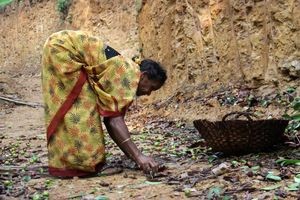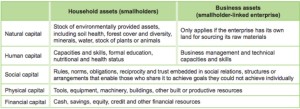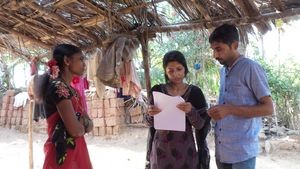Adapted from Bioversity International

A new tool to assess poverty in a gender-responsive way is set to prove its value in a pilot phase, starting mid-2016 in India, Peru and Guatemala. To prepare for the launch of the methodology called 5Capitals-G, field researchers from three parts of India were trained in a workshop in April. The training was co-funded by the CGIAR Research Program on Forests, Trees and Agroforestry.
Over the past decade, value chain development (VCD) involving smallholders has become more and more important for actors who want to reduce rural poverty. Donors, governments and private sector have invested millions of dollars in value chain development, but fairly little is known to what extent such initiatives effectively reduce poverty. This is partially due to the fact that appropriate methodologies and tools for assessing the impacts of value chain development on poverty are not readily available.
Researchers from the World Agroforestry Centre (ICRAF), Bioversity International, CATIE and multiple partners around the globe addressed this gap by developing the learning tool 5Capitals. It uses an asset-based approach for assessing the poverty impacts of value chain development at the level of both smallholder households and the enterprises that link these farmers with processors and buyers downstream the value chain. The data will be obtained through, for example, key informant interviews, household surveys and analysis of secondary information.
To take into consideration gender in this methodology, Bioversity International and the World Agroforestry Centre (ICRAF) are developing 5Capitals-G, which will be piloted mid-2016 in India, Guatemala and Peru.

5Capitals-G looks at the poverty levels of both smallholder households and enterprises, collecting data from both women and men. Researchers assess household and business assets, as described in this table from the 5Capitals handbook.
The training was held in Karnataka, where students from the College of Forestry in Sirsi will be testing the 5Capitals-G tool to study the value chains of three forest fruit species: Garcinia indica (kokum), Mangifera indica (mango), and Garcinia gummi-gutta (brindleberry).
The workshop laid out the conceptual foundation of an asset-based approach to value chain development and the importance of applying a gender lens to identify the access to and control over assets. Access and control differ between women and men.
The participants pre-tested the different elements of the tool for final refinement, visiting the farmers’ cooperative society Kadamba in Sirsi, which has more than 2,000 members from across Karnataka. For many of the participating students, this was a first experience in conducting key informant, household and enterprise interviews.
They interviewed the CEO and several female and male employees and learned that the cooperative provides diverse income-earning opportunities by purchasing close to 30 agricultural and forest products cultivated or collected by their members. One of the products the cooperative buys is kokum, which they process into fresh juices and powered juice crystals.
Leaders of three Village Forest Committees explained how they manage sustainability issues linked with the collection and commercialization of forest products.
For the household assessments, participants asked women and men smallholders in their homes to understand their experiences with marketing kokum and the ways their involvement in the kokum value chain ties in with the many other activities they pursue to make a living.

Participants grouped into mixed teams of men and women interviewers to first interview the male and female households jointly. Then the women interviewers continued with the female respondents and the male interviewers with the male respondents to appreciate differences in the perspectives and realities of women and men. Some of them were surprised to learn how a man and a woman of the same household may differ in their perception of who makes decisions on what.
The main takeaways from the workshop were:
- It is critical to account for diverse and even conflicting views and needs of women and men in both the households and smallholder enterprises.
- The design and monitoring of value chain interventions requires specific engagement with men and women to ensure that both benefit form value chain development in an equitable way.
Shambhavi Priyam, a young researcher working with Action for Social Advancement in Madhya Pradesh, reflected that “it was amazing to see the nitty-gritties which have to be considered when designing a tool with gender consideration. There is no ‘one size fits all’ system for social research”.
The introduction of young researchers in India and elsewhere to the concepts of gender-responsive research in relation to value chain development will allow them to increase the depth of their work and their capacity to develop gender-equitable solutions for eliminating poverty.
This blog draws on the experience of
- Dietmar Stoian, Principal Scientist, Value Chains and Private Sector Engagement,
- Gennifer Meldrum, Research Fellow, Nutrition and Marketing Diversity
- Marlène Elias, Gender Specialist, Conservation and Management of Forest Genetic Resources
The training was implemented as part of the project ‘Innovations in Ecosystem Management and Conservation (IEMaC)’ with support from the CGIAR Research Program on Policies, Institutions and Markets (PIM). The IEMaC project is funded by the InFoRM (Innovations in Forest Resource Management) program of USAID, which aims to reduce forest degradation in India, with co-funding from the CGIAR Research Program on Forests, Trees and Agroforestry (FTA). Participants in the workshop also included partners of the project ‘Linking agrobiodiversity value chains, climate adaptation and nutrition: Empowering the poor to manage risk’ that is supported by IFAD, the European Union and the CGIAR Research Program of Climate Change Agriculture and Food Security (CCAFS) promoting value chain development of minor millets.











